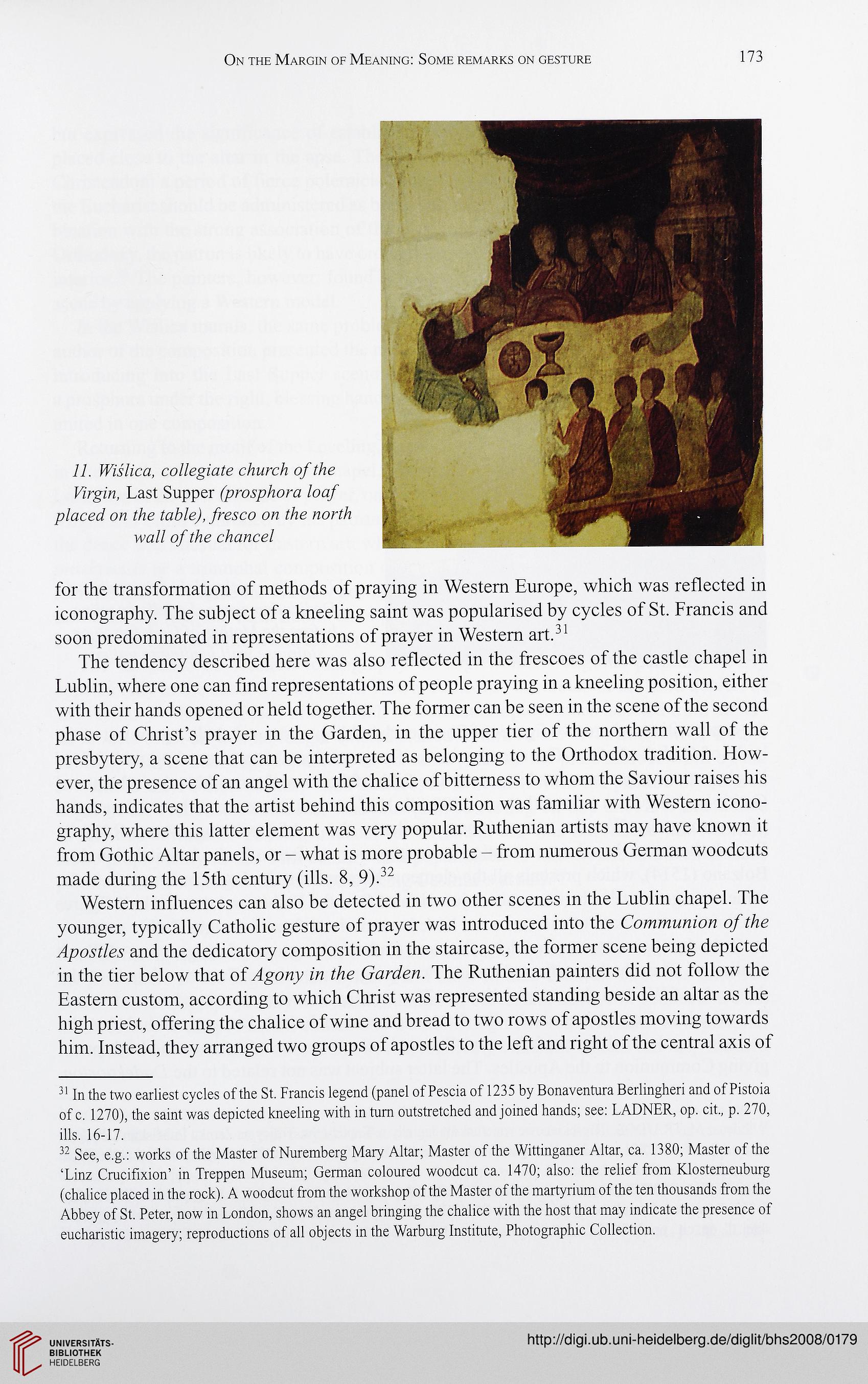ON THE MARGIN OF MEANING! SOME REMARKS ON GESTURE
173
77. cAurcA of fAg
HrgtH, Last Supper (pro^Aorn /ou/'
p/ucer/ on fAe ^oA/p), /Ae^co on fAe norfA
wu// of fAe cAonco/
for the transformation of methods of praying in Western Europe, which was reflected in
iconography. The subject of a kneeling saint was popularised by cycles of St. Francis and
soon predominated in representations of prayer in Western art.^
The tendency described here was also reflected in the frescoes of the castle chapel in
Lublin, where one can End representations of people praying in a kneeling position, either
with their hands opened or held together. The former can be seen in the scene of the second
phase of Christ's prayer in the Garden, in the upper tier of the northern wall of the
presbytery, a scene that can be interpreted as belonging to the Orthodox tradition. How-
ever, the presence of an angel with the chalice of bitterness to whom the Saviour raises his
hands, indicates that the artist behind this composition was familiar with Western icono-
graphy, where this latter element was very popular. Ruthenian artists may have known it
from Gothic Altar panels, or - what is more probable - from numerous German woodcuts
made during the 15th century (ills. 8, 9).^
Western influences can also be detected in two other scenes in the Lublin chapel. The
younger, typically Catholic gesture of prayer was introduced into the Cownmn/oH q/ /Ag
and the dedicatory composition in the staircase, the former scene being depicted
in the tier below that of Hgony m /A<? Gurr/gn. The Ruthenian painters did not follow the
Eastern custom, according to which Christ was represented standing beside an altar as the
high priest, offering the chalice of wine and bread to two rows of apostles moving towards
him. Instead, they arranged two groups of apostles to the left and right of the central axis of
In the two earliest cycles of the St. Francis iegend (panel of Pescia of 1235 by Bonaventura Beriingheri and of Pistoia
of c. 1270), the saint was depicted kneeling with in turn outstretched and joined hands; see: LADNER, op. cit., p. 270,
ills. 16-17.
^ See, e.g.: works of the Master of Nuremberg Mary Altar; Master of the Wittinganer Altar, ca. 1380; Master of the
'Linz Crucifixion' in Treppen Museum; German coloured woodcut ca. 1470; also: the relief from Klosterneuburg
(chalice placed in the rock). A woodcut from the workshop of the Master of the martyrium of the ten thousands from the
Abbey of St. Peter, now in London, shows an angel bringing the chalice with the host that may indicate the presence of
eucharistie imagery; reproductions of all objects in the Warburg Institute, Photographic Collection.
173
77. cAurcA of fAg
HrgtH, Last Supper (pro^Aorn /ou/'
p/ucer/ on fAe ^oA/p), /Ae^co on fAe norfA
wu// of fAe cAonco/
for the transformation of methods of praying in Western Europe, which was reflected in
iconography. The subject of a kneeling saint was popularised by cycles of St. Francis and
soon predominated in representations of prayer in Western art.^
The tendency described here was also reflected in the frescoes of the castle chapel in
Lublin, where one can End representations of people praying in a kneeling position, either
with their hands opened or held together. The former can be seen in the scene of the second
phase of Christ's prayer in the Garden, in the upper tier of the northern wall of the
presbytery, a scene that can be interpreted as belonging to the Orthodox tradition. How-
ever, the presence of an angel with the chalice of bitterness to whom the Saviour raises his
hands, indicates that the artist behind this composition was familiar with Western icono-
graphy, where this latter element was very popular. Ruthenian artists may have known it
from Gothic Altar panels, or - what is more probable - from numerous German woodcuts
made during the 15th century (ills. 8, 9).^
Western influences can also be detected in two other scenes in the Lublin chapel. The
younger, typically Catholic gesture of prayer was introduced into the Cownmn/oH q/ /Ag
and the dedicatory composition in the staircase, the former scene being depicted
in the tier below that of Hgony m /A<? Gurr/gn. The Ruthenian painters did not follow the
Eastern custom, according to which Christ was represented standing beside an altar as the
high priest, offering the chalice of wine and bread to two rows of apostles moving towards
him. Instead, they arranged two groups of apostles to the left and right of the central axis of
In the two earliest cycles of the St. Francis iegend (panel of Pescia of 1235 by Bonaventura Beriingheri and of Pistoia
of c. 1270), the saint was depicted kneeling with in turn outstretched and joined hands; see: LADNER, op. cit., p. 270,
ills. 16-17.
^ See, e.g.: works of the Master of Nuremberg Mary Altar; Master of the Wittinganer Altar, ca. 1380; Master of the
'Linz Crucifixion' in Treppen Museum; German coloured woodcut ca. 1470; also: the relief from Klosterneuburg
(chalice placed in the rock). A woodcut from the workshop of the Master of the martyrium of the ten thousands from the
Abbey of St. Peter, now in London, shows an angel bringing the chalice with the host that may indicate the presence of
eucharistie imagery; reproductions of all objects in the Warburg Institute, Photographic Collection.




